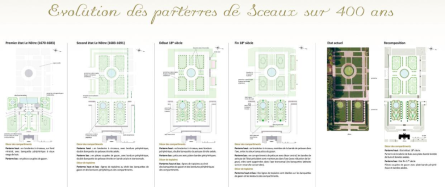France this year celebrates the 400th birth year of one of the most influential garden architects ever: André le Nôtre (1613-1700). In light of that anniversary, parts of his designs at Parc de Sceaux are being restored. Maybe recreated is a better term for the layout of the parterres de broderie that is currently going on. The restoration goes back to the situation after Le Nôtre’s second round at Sceaux in the 1680s.
The Domaine de Sceaux simultaneously set up an entire program of lectures and exhibitions around Le Nôtre, his work in general and at Sceaux in particular. The details of the restoration and surrounding program can be found here (in French).
An information package (for the press), with designs and the evolution of the parterres since the 17th century, can be found here. 1Including a page showing ‘Evolution des parterres de Sceaux sur 400 ans‘, forgetting that we are now celebrating Le Nôtre’s birth 400 years ago. Work on the parterres could only have started after 1670, a ‘mere’ 343 years ago…
Box / Buxus / Buis
What strikes me is the fact that while in some big gardens in Holland the box plantations are being replaced by plants that do not suffer from the diseases box has, the parterres de broderie at Parc de Sceaux are planted with 6 km of exactly that plant. I can understand that when one restores a garden layout in the year of the architect’s anniversary, one is inclined to use the sorts and species we know that architect originally used. But the way box diseases are spreading over Europe, this may not turn out to be the most prudent decision.
Pickets
Another interesting difference in approach is the fact that at Sceaux no corten steel strips or other materials are used to help keep the lines of the parterres intact. At Het Loo corten steel strips now do the work that was previously done by plastic strips (dating from the reconstruction over 30 years ago). At Assumburg they used a different approach, it seems. But neither one of them created their parterres with the simple, probably much cheaper and hopefully effective method that this video of the work at Sceaux shows.
[Edit July 24, 2013: @LeNostre (the Twitter-handle of André le Nôtre) pointed out to me that at Sceaux metal strips are actually used to form the volutes. Thus rendering the above section pointless. I could have known, because it is mentioned on page 12 of the presentation I myself refer to above.]
It will be interesting to check in again in about ten years from now and see how the lines of the parterres at Het Loo and at Parc de Sceaux, both (re)planted in the spring of 2013, developped. Keeping in mind that at Het Loo, no box is used, but Ilex crenata; and that Sceaux is a public park used for daily recreation (Het Loo is a museum garden).
Related articles
Footnotes
| ↑1 | Including a page showing ‘Evolution des parterres de Sceaux sur 400 ans‘, forgetting that we are now celebrating Le Nôtre’s birth 400 years ago. Work on the parterres could only have started after 1670, a ‘mere’ 343 years ago… |
|---|







The link “An information package (for the press), with designs and the evolution of the parterres since the 17th century, can be found here. 1” is not working, is there any way I can get access to a clearer version of the ‘Evolution des parterres de Sceaux sur 400 ans’?
Hi Anna, thanks for pointing this out.
I usually try to regain access by pasting the url in the search box of the Internet Archive on waybackmachine.org, but that didn’t help in this case.
I guess the département either deleted or moved the document or has reorganized its site in such a way the old url’s are not working anymore. Unfortunately I haven’t saved a copy myself, but you may find one by asking the département directly?